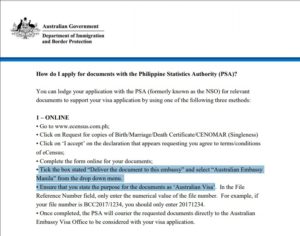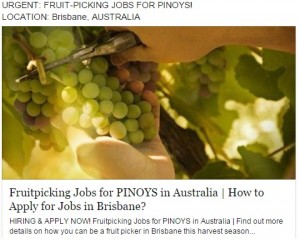Applying for the Australian Prospective Marriage Visa [PMV subclass 300]
Applications for the Australian Prospective Marriage Visa [PMV] are normally done online via the Australian Governments Immigration website. (online.immi.gov.au/lusc/login)
When you begin the application, most of it is self explanatory, and you will complete what was the old paper based form 47SP, as part of the online application.
Your sponsor will do the same with the old Form 40SP, when he/she does the sponsor part. This can be done in the same IMMI account as yours.
You will need to get a new Birth Certificate and a CENOMAR from the PSA, and that must be sent direct to the Australian embassy, from the PSA. (psa.gov.ph/…/birth-certificate) and (psa.gov.ph/…/cenomar)
CENOMAR is a Certificate of No Marriage Record. It is a certification issued by the PSA stating that a person has not contracted any marriage. It is also called a certificate of No Record of Marriage or Certificate of Singleness.
The application does have instructions for that, with exactly what to put on the request form to the PSA.
Two people need to complete form 888’s, or similar, to confirm that they know of the existence of the relationship. That can often be the sponsors relatives.
You also need to arrange a Notice of Intended Marriage form (NOIM), which can be done by most Australian Marriage Celebrants. Probably best to be the one you will use to do your marriage.
If you set a date a year after application, you can always change it later, just make sure your Marriage Celebrant is aware of that possibility.
The rest is mainly proof that you know each other and have met at least once, but have had plenty of other contact.
The more proof should mean a faster processing time.
Applying for the Birth Certificate or CENOMAR for an Australian Visa
This information is correct at time of publication, but subject to changes made by the Australian or Philippine Governments.
-
- Go to www.psaserbilis.com.ph (Previously: www.ecensus.com.ph).
- Click on Request for copies of Birth/Marriage/Death Certificate/CENOMAR (Singleness).
- Click on ‘I accept’ on the declaration that appears requesting you agree to terms/conditions of eCensus.
- Complete the form online for your documents;
- Tick the box stated “Deliver the document to this embassy” and select “Australian Embassy Manila” from the drop down menu.
- Ensure that you state the purpose for the documents as ‘Australian Visa’. In the File Reference Number field, only enter the numerical value of the file number. For example, if your file number is BCC2017/1234, you should only enter 20171234.
- Once completed, the PSA will courier the requested documents directly to the Australian Embassy Visa Office to be considered with your visa application.
- Source: philippines.embassy.gov.au/…/Requesting PSA documents.pdf


